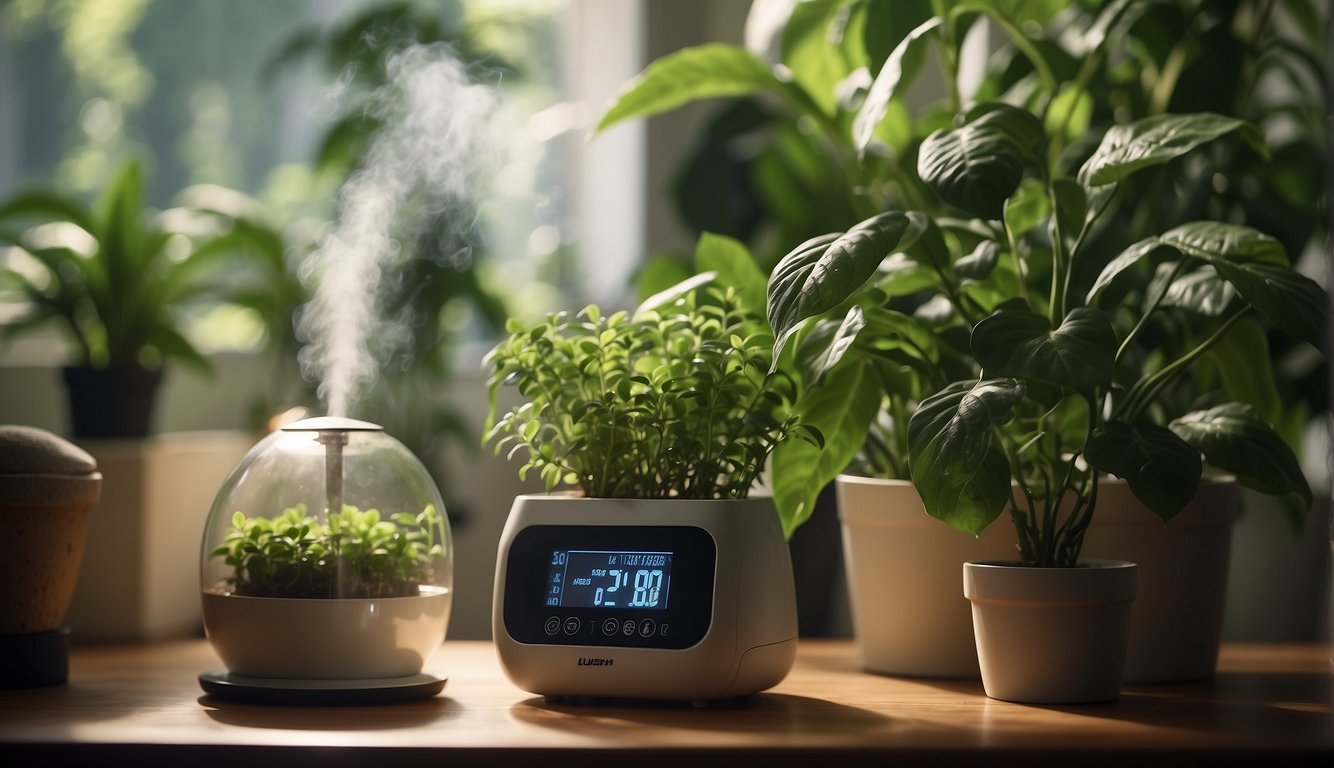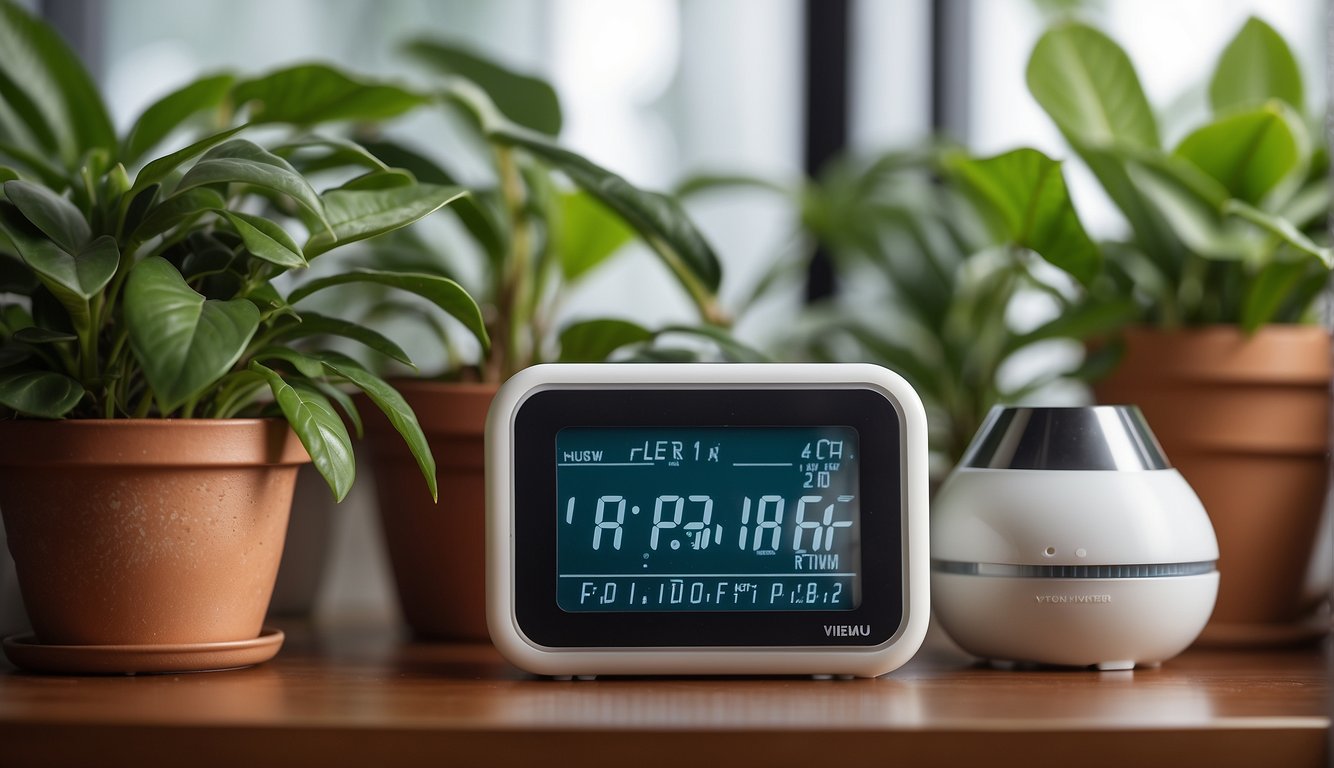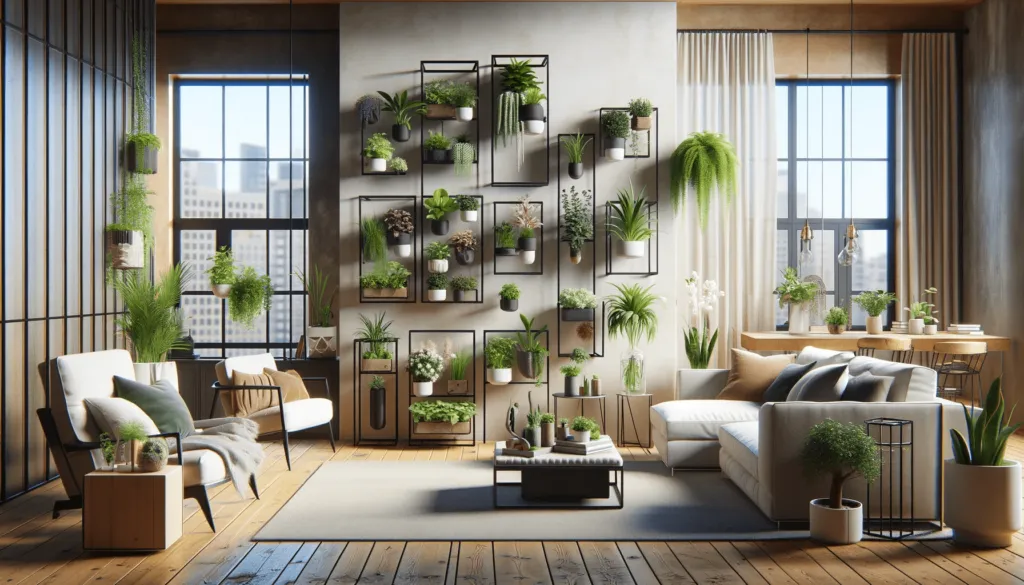Indoor gardening is a great way to bring some greenery into your home, but it can be challenging to maintain the right environment for healthy plant growth. One of the most important factors to consider is humidity control. Indoor garden humidity control is crucial for plant health, as too much or too little humidity can cause a variety of problems.

Understanding humidity is the first step in creating the ideal environment for your indoor garden. Humidity refers to the amount of moisture in the air, and it can have a significant impact on plant growth. Most plants prefer a humidity level between 40% and 60%, but some plants require higher or lower humidity levels. Creating the ideal environment for your plants involves managing the humidity levels, as well as other factors such as temperature, light, and air circulation.
Table of Contents
Key Takeaways:
- Maintaining proper humidity levels is crucial for healthy indoor plant growth.
- Understanding the ideal humidity range for your specific plant species is key to successful indoor gardening.
- Managing water, selecting the right plants, and using the proper tools and equipment can all help you maintain the ideal humidity levels for your indoor garden.
Understanding Humidity
Humidity is an essential factor in indoor gardening. It refers to the amount of moisture present in the air. The amount of humidity in the air affects plant health and growth. In this section, we’ll discuss the role of humidity in plant health and how to measure humidity levels.
The Role of Humidity in Plant Health
Humidity plays a crucial role in plant health. Plants absorb moisture through their leaves and roots. The amount of moisture that a plant can absorb depends on the humidity levels in the air. If the air is too dry, plants can’t absorb enough moisture and will wilt. On the other hand, if the air is too humid, plants can’t release moisture through their leaves, and the excess moisture can lead to fungal growth and other diseases.
Measuring Humidity Levels
Measuring humidity levels is important to ensure that the humidity in your indoor garden is at the right level for your plants. You can measure humidity levels using a hygrometer. A hygrometer is a device that measures relative humidity. Relative humidity is the amount of moisture present in the air compared to the maximum amount of moisture that the air can hold at a given temperature.
The ideal humidity level for indoor gardening depends on the type of plants you are growing. Some plants require high humidity levels, while others require low humidity levels. Most indoor plants thrive in a relative humidity range of 40% to 60%. However, it’s essential to research the humidity requirements of your specific plants to ensure that you are providing the right environment for them to grow.
In summary, understanding humidity is crucial to indoor gardening. Measuring humidity levels and controlling humidity in your indoor garden can help ensure that your plants are healthy and thriving.
Creating the Ideal Environment
When it comes to indoor gardening, creating the ideal environment is crucial for the success of your plants. In addition to providing the right temperature and airflow, proper light and insulation are also essential factors to consider.
Temperature and Airflow
Maintaining a consistent temperature is important for the health of your plants. Temperature fluctuation can cause stress and damage to plants, so it’s important to monitor the temperature regularly and make adjustments as necessary. Investing in a temperature control system can help maintain a stable environment for your plants.
Air circulation and ventilation are also important for maintaining a healthy environment for your plants. Proper airflow will help prevent the buildup of mold and mildew, which can be harmful to your plants. Using oscillating fans or installing a ventilation system can help improve air circulation.
Light and Insulation
Light is essential for the growth and development of plants. Different plants have different light requirements, so it’s important to research the specific needs of your plants. Grow lights can be used to supplement natural light or as the primary source of light for your plants.
Insulation is also important for maintaining a stable environment for your plants. Poor insulation can result in temperature fluctuations and can make it difficult to maintain a consistent environment. Using insulation materials such as reflective films or foam insulation can help regulate temperature and reduce energy costs.
Overall, creating the ideal environment for your indoor garden requires attention to detail and regular monitoring. By maintaining proper temperature, airflow, light, and insulation, you can help ensure the health and success of your plants.
Managing Water in Your Indoor Garden
Maintaining proper water levels is crucial for the health of your indoor garden. Overwatering can lead to root rot and other plant diseases, while underwatering can cause your plants to wilt and die. In this section, we will discuss some watering techniques and tips to prevent overwatering and rot.
Watering Techniques
When it comes to watering your indoor garden, there are several techniques you can use. The most common method is to water your plants from the top, either by pouring water directly onto the soil or using a watering can. However, this can lead to overwatering and soil compaction.
Another technique is bottom watering, which involves placing your plants in a tray of water and allowing them to absorb water through the drainage holes in the bottom of the pot. This method can help prevent overwatering and promote healthy root growth.
Preventing Overwatering and Rot
Overwatering is a common problem in indoor gardens and can lead to root rot and other plant diseases. To prevent overwatering, it is important to establish a watering schedule and stick to it. Most indoor plants prefer to dry out between waterings, so be sure to let the soil dry out completely before watering again.
Another way to prevent overwatering is to use a moisture meter to check the soil’s moisture level. Moisture meters are affordable and easy to use, and they can help you avoid overwatering and underwatering your plants.
Misting your plants can also help increase humidity levels in your indoor garden, which is important for moisture-loving plants. However, be careful not to mist your plants too much, as this can lead to water buildup and promote the growth of mold and other plant diseases.
In addition to these techniques, it is also important to choose the right type of soil for your indoor garden. Moisture-retaining soil can help prevent overwatering, while well-draining soil can help prevent root rot.
By following these watering techniques and tips, you can help ensure the health and longevity of your indoor garden.
Selecting and Caring for Plants
When it comes to indoor gardening, selecting the right plants is crucial for the success of your garden. We recommend choosing plants that are suited to the indoor environment and require similar care. This will make it easier to maintain a consistent environment and ensure that your plants thrive.
Choosing the Right Plants
Some plants are better suited to indoor environments than others. Tropical plants, ferns, succulents, orchids, cacti, air plants, and seedlings are all great options for indoor gardening. These plants are generally low-maintenance and can tolerate the lower light levels and drier air found indoors.
When selecting plants, it’s important to consider the specific conditions in your home. For example, if your home is particularly dry, you may want to choose plants that are more tolerant of low humidity levels. On the other hand, if your home is naturally humid, you may want to choose plants that are more tolerant of high humidity levels.
Specific Care for Humidity-Loving Species
Humidity-loving plants, such as herbs, snake plants, and spider plants, require specific care to thrive. These plants prefer a more humid environment and can benefit from additional humidity. To increase humidity levels, we recommend placing a tray of water near your plants or using a humidifier.
It’s also important to avoid over-watering these plants, as too much water can lead to root rot and other problems. Instead, water them only when the soil feels dry to the touch.
In addition to humidity, these plants also require adequate light and nutrients to support healthy growth. Be sure to provide them with the right conditions and watch them thrive!
Tools and Equipment
Maintaining the proper humidity level is crucial for indoor gardening. To help manage humidity, we need to have the right tools and equipment. Here are some of the essential items we recommend:
Humidity Monitor
A humidity monitor is an essential tool for indoor gardening. It helps us keep track of the humidity level and make necessary adjustments. We can choose from a variety of monitors, including digital and analog ones. Some monitors also have additional features like temperature readings.
Humidifier/Dehumidifier
Humidifiers and dehumidifiers help us manage humidity levels in our indoor garden. Humidifiers add moisture to the air when the humidity is low, while dehumidifiers remove excess moisture when the humidity is high. We can choose from different types of humidifiers and dehumidifiers, such as cool mist, warm mist, and misters.
Fans
Fans are a useful tool for indoor gardening as they help circulate air and reduce humidity levels. We can use different types of fans, including ceiling fans, floor fans, and table fans.
Heating and Cooling Systems
Heating and cooling systems are essential for indoor gardening, especially in areas with extreme temperatures. We can choose from different types of heating and cooling systems, such as heaters, air conditioners, and thermostats. These systems help us maintain a consistent temperature and humidity level in our indoor garden.
Humidity Trays
Humidity trays are useful for plants that require higher humidity levels. We can place the plant on top of the tray, which is filled with water. The water evaporates, creating a humid environment around the plant.
Misters
Misters are useful for plants that require a humid environment. We can use misters to spray water on the plants, which helps increase humidity levels.
Potting Mix and Nutrients
Potting mix and nutrients are essential for indoor gardening. We can choose from different types of potting mix, such as peat moss, vermiculite, and perlite. Nutrients are also necessary for plant growth, and we can choose from different types of fertilizers.
Decor
Decor is an important aspect of indoor gardening. We can choose from different types of decor, such as terrariums, which help create a humid environment for plants. We can also add other decorative items such as rocks, statues, and lights to enhance the aesthetic appeal of our indoor garden.
In summary, managing humidity levels in our indoor garden is crucial, and we need to have the right tools and equipment to do so. We can choose from a variety of items, including humidity monitors, humidifiers, dehumidifiers, fans, heating and cooling systems, humidity trays, misters, potting mix, nutrients, and decor.
Frequently Asked Questions

What are the best methods for controlling humidity in an indoor garden?
There are several effective methods for controlling humidity in an indoor garden. One of the simplest methods is to use a humidifier to increase humidity levels, especially during dry winter months. Conversely, a dehumidifier can be used to reduce humidity levels during the summer months. Other methods include using ventilation fans, air conditioning, and evaporative cooling systems. It is important to monitor humidity levels regularly using a hygrometer to ensure that they remain within the optimal range.
How can I reduce humidity levels in a grow tent without using a dehumidifier?
If you want to reduce humidity levels in your grow tent without using a dehumidifier, there are a few methods you can try. One method is to increase ventilation by opening windows or using fans to circulate air. Another method is to use a desiccant, such as silica gel or activated charcoal, which can absorb excess moisture from the air. Additionally, placing a bucket of uncooked rice or rock salt in the grow tent can help absorb moisture.
What is the ideal humidity range for a grow tent, and how do I maintain it?
The ideal humidity range for a grow tent varies depending on the stage of plant growth. During the vegetative stage, the humidity should be between 40-70%. During the flowering stage, the humidity should be between 40-50%. To maintain these levels, it is important to monitor humidity regularly using a hygrometer and adjust the environment accordingly. This can include using a humidifier or dehumidifier, increasing or decreasing ventilation, or adjusting the temperature.
How do I increase the humidity in my grow tent if it’s too low?
If the humidity in your grow tent is too low, there are several methods you can try to increase it. One method is to use a humidifier, which can add moisture to the air. Another method is to place a tray of water near the plants, which can increase humidity through evaporation. Additionally, misting the plants with water can help increase humidity levels.
Can I use an automatic humidity controller in my grow tent, and how does it work?
Yes, you can use an automatic humidity controller in your grow tent. An automatic humidity controller works by using a hygrometer to monitor humidity levels in the grow tent. If the humidity falls outside of the desired range, the controller will activate a humidifier or dehumidifier to adjust the environment accordingly. This can help maintain optimal humidity levels without the need for constant monitoring.
What are the effects of low humidity on indoor plants, and is 30% humidity too low?
Low humidity can have several negative effects on indoor plants, including stunted growth, wilting, and leaf drop. Additionally, low humidity can make plants more susceptible to pests and diseases. While the ideal humidity range varies depending on the stage of plant growth, 30% humidity is generally considered too low for most indoor plants. It is important to monitor humidity levels regularly and adjust the environment accordingly to ensure optimal plant growth.


